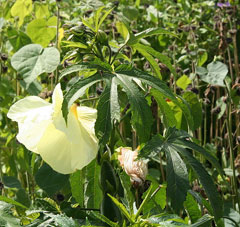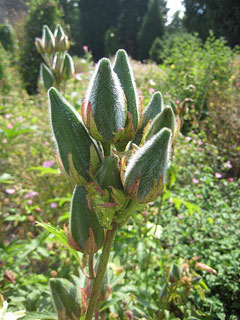 |
|
http://de.wikipedia.org/wiki/Benutzer:Michael_w |
 |
|
Translate this page:
Summary
Physical Characteristics

 Abelmoschus manihot is a PERENNIAL growing to 3 m (9ft) by 2 m (6ft) at a fast rate.
Abelmoschus manihot is a PERENNIAL growing to 3 m (9ft) by 2 m (6ft) at a fast rate.
See above for USDA hardiness. It is hardy to UK zone 9 and is frost tender. It is in flower from July to September, and the seeds ripen from August to October. The species is hermaphrodite (has both male and female organs) and is pollinated by Insects.
Suitable for: light (sandy), medium (loamy) and heavy (clay) soils and prefers well-drained soil. Suitable pH: mildly acid, neutral and basic (mildly alkaline) soils. It cannot grow in the shade. It prefers moist soil.
UK Hardiness Map
US Hardiness Map
Synonyms
Hibiscus manihot.
Plant Habitats
Cultivated Beds;
Edible Uses
Edible Parts: Flowers Leaves Shoots
Edible Uses:
Young leaves - raw or cooked[183 , 200 ]. Sweet and mucilaginous[183 , 300 ]. The leaves are high in vitamins A and C, and iron, and have 2% protein by dry weight. Young leaves can be used as a lettuce substitute[298 ] or a spinach substitute. Young shoots are harvested when about 15cm long[300 ]. Flower buds - raw or cooked[183 ]. There is a wide range of other leaf shapes.
References More on Edible Uses
Medicinal Uses
Plants For A Future can not take any responsibility for any adverse effects from the use of plants. Always seek advice from a professional before using a plant medicinally.
Emmenagogue Odontalgic Vulnerary
The bark is said to be emmenagogue[240]. A paste of the bark is used to treat wounds and cuts, with new paste being applied every 2 - 3 days for about 3 weeks[272]. In Nepal the root juice is warmed and applied to sprains[272]. The juice of the flowers is used to treat chronic bronchitis and toothache[272].
References More on Medicinal Uses
The Bookshop: Edible Plant Books
Our Latest books on Perennial Plants For Food Forests and Permaculture Gardens in paperback or digital formats.

Edible Tropical Plants
Food Forest Plants for Hotter Conditions: 250+ Plants For Tropical Food Forests & Permaculture Gardens.
More

Edible Temperate Plants
Plants for Your Food Forest: 500 Plants for Temperate Food Forests & Permaculture Gardens.
More

More Books
PFAF have eight books available in paperback and digital formats. Browse the shop for more information.
Shop Now
Other Uses
The root of this plant is used by the Japanese as a size for their handmade papers, which are prepared from the inner bark of Edgeworthia gardneri and several varieties of the paper mulberry (Broussonetya papyrifera). The root is macerated in water and added to the paper pulp. The mucilage is obtained from the roots of this plant as follows:- Wash off the dirt, soak in fresh water for some hours, and crush them to pieces. The substance thus prepared should then be put in a linen bag and soaked again in water. When the material gets thoroughly soft, the juice comes out of the bag by manipulating in the vat in which pulp has been previously mixed to receive the paste. The bag should be squeezed now and then, as the mucilage does not come out by itself. The paper maker can judge whether sufficient mucilage is in the water or not by its glutinous consistency. This is the best mucilaginous plant extensively used in Japan[511 ].
Special Uses
References More on Other Uses
Cultivation details
A short-lived perennial shrub. Plants grow well in lowland tropical areas, with yields beginning to drop when they are grown at elevations above 500 metres. They may develop an annual habit of growth at higher elevations and in cooler climates[300 ]. They are generally tender in the temperate zone but can be grown outdoors as an annual, flowering well in their first year and setting seed[200 , K ]. They will occasionally overwinter in a cold greenhouse in the temperate zone[K ]. Plants have a high moisture requirement and grow best in areas with an evenly distributed annual precipitation of 1,000mm or more[300 ]. They prefer a relatively high humidity and a stable temperature above 25°c, though they can tolerate occasional short-lived lows down to about -5°c so long as they are in a very well-drained soil[260 , 300 ]. Easily grown in any well-drained soil in a sunny position[200 ]. Plants are most productive when grown in well-prepared fertile soils that are rich in organic matter[300 ]. When well looked after, the plant can be highly productive - yields of 40 - 60 tonnes per hectare have been achieved in the tropics[298 , 300 ]. A very variable plant[300 ]. Plants do not flower well when day length is less than 12 hours[300 ]. Plants are somewhat susceptible to root nematodes[298 ]. It grows well in an ornamental vegetable garden[200 ].
References Carbon Farming Information and Carbon Sequestration Information
Temperature Converter
Type a value in the Celsius field to convert the value to Fahrenheit:
Fahrenheit:
The PFAF Bookshop
Plants For A Future have a number of books available in paperback and digital form. Book titles include Edible Plants, Edible Perennials, Edible Trees,Edible Shrubs, Woodland Gardening, and Temperate Food Forest Plants. Our new book is Food Forest Plants For Hotter Conditions (Tropical and Sub-Tropical).
Shop Now
Plant Propagation
Seed - sow March in a warm greenhouse. The seed should germinate with two weeks, when it is large enough to handle prick it out into individual pots and plant out after the last expected frosts. The seed can also be sown in situ in late April in areas with warm summers.
Other Names
If available other names are mentioned here
Aibika, hibiscus spinach, ibika, bele, vauvau (Fiji), pele (Polynesia), ailan kapis (Vanuatu), tororo aoi (Japan), sunset muskmallow, sunset hibiscus, hibiscus manihot, lettuce tree, Queensland greens
Native Range
ASIA-TEMPERATE: China: Fujian Sheng, Henan Sheng, Hebei Sheng, Hunan Sheng, Hubei Sheng, Guangdong Sheng, Guizhou Sheng, Shandong Sheng, Shaanxi Sheng, Sichuan Sheng, Yunnan Sheng, Guangxi Zhuangzu Zizhiqu, Taiwan. ASIA-TROPICAL: Bhutan, India, Nepal, Pakistan, Papua New Guinea, Myanmar, Thailand (north), Indonesia, Malaysia, Philippines.
Weed Potential
Right plant wrong place. We are currently updating this section.
Please note that a plant may be invasive in one area but may not in your area so it's worth checking.
Conservation Status
IUCN Red List of Threatened Plants Status :

Growth: S = slow M = medium F = fast. Soil: L = light (sandy) M = medium H = heavy (clay). pH: A = acid N = neutral B = basic (alkaline). Shade: F = full shade S = semi-shade N = no shade. Moisture: D = dry M = Moist We = wet Wa = water.
Now available:
Food Forest Plants for Mediterranean Conditions
350+ Perennial Plants For Mediterranean and Drier Food Forests and Permaculture Gardens.
[Paperback and eBook]
This is the third in Plants For A Future's series of plant guides for food forests tailored to
specific climate zones. Following volumes on temperate and tropical ecosystems, this book focuses
on species suited to Mediterranean conditions—regions with hot, dry summers and cool, wet winters,
often facing the added challenge of climate change.
Read More
Expert comment
Author
(L.)Medik.
Botanical References
200266
Links / References
For a list of references used on this page please go here
A special thanks to Ken Fern for some of the information used on this page.
Readers comment